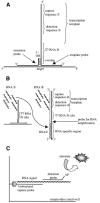Specific detection of DNA and RNA targets using a novel isothermal nucleic acid amplification assay based on the formation of a three-way junction structure
- PMID: 11376166
- PMCID: PMC55724
- DOI: 10.1093/nar/29.11.e54
Specific detection of DNA and RNA targets using a novel isothermal nucleic acid amplification assay based on the formation of a three-way junction structure
Abstract
The formation of DNA three-way junction (3WJ) structures has been utilised to develop a novel isothermal nucleic acid amplification assay (SMART) for the detection of specific DNA or RNA targets. The assay consists of two oligonucleotide probes that hybridise to a specific target sequence and, only then, to each other forming a 3WJ structure. One probe (template for the RNA signal) contains a non-functional single-stranded T7 RNA polymerase promoter sequence. This promoter sequence is made double-stranded (hence functional) by DNA polymerase, allowing T7 RNA polymerase to generate a target-dependent RNA signal which is measured by an enzyme-linked oligosorbent assay (ELOSA). The sequence of the RNA signal is always the same, regardless of the original target sequence. The SMART assay was successfully tested in model systems with several single-stranded synthetic targets, both DNA and RNA. The assay could also detect specific target sequences in both genomic DNA and total RNA from Escherichia coli. It was also possible to generate signal from E.coli samples without prior extraction of nucleic acid, showing that for some targets, sample purification may not be required. The assay is simple to perform and easily adaptable to different targets.
Figures






Similar articles
-
Use of signal-mediated amplification of RNA technology (SMART) to detect marine cyanophage DNA.Biotechniques. 2002 Mar;32(3):604-6, 608-11. doi: 10.2144/02323rr02. Biotechniques. 2002. PMID: 11926174
-
The helper oligonucleotides enable detection of folded single-stranded DNA by lateral flow immunoassay after HCR signal amplification.Talanta. 2022 Oct 1;248:123588. doi: 10.1016/j.talanta.2022.123588. Epub 2022 May 29. Talanta. 2022. PMID: 35661000
-
Three-way junction-induced isothermal amplification for nucleic acid detection.Biosens Bioelectron. 2020 Jan 1;147:111762. doi: 10.1016/j.bios.2019.111762. Epub 2019 Oct 6. Biosens Bioelectron. 2020. PMID: 31654822
-
Nucleic acid amplification mediated microbial identification.Sci Prog. 1993-1994;77 ( Pt 3-4):183-206. Sci Prog. 1993. PMID: 7536958 Review.
-
Isothermal amplified detection of DNA and RNA.Mol Biosyst. 2014 May;10(5):970-1003. doi: 10.1039/c3mb70304e. Mol Biosyst. 2014. PMID: 24643211 Review.
Cited by
-
Detection of virus mRNA within infected host cells using an isothermal nucleic acid amplification assay: marine cyanophage gene expression within Synechococcus sp.Virol J. 2007 Jun 6;4:52. doi: 10.1186/1743-422X-4-52. Virol J. 2007. PMID: 17553149 Free PMC article.
-
Toward a next-generation diagnostic tool: A review on emerging isothermal nucleic acid amplification techniques for the detection of SARS-CoV-2 and other infectious viruses.Anal Chim Acta. 2022 May 29;1209:339338. doi: 10.1016/j.aca.2021.339338. Epub 2021 Dec 1. Anal Chim Acta. 2022. PMID: 35569864 Free PMC article. Review.
-
Evaluation of an isothermal signal amplification method for rapid detection of methicillin-resistant Staphylococcus aureus from patient-screening swabs.J Clin Microbiol. 2003 Jul;41(7):3187-91. doi: 10.1128/JCM.41.7.3187-3191.2003. J Clin Microbiol. 2003. PMID: 12843062 Free PMC article.
-
Development of Isothermal Recombinase Polymerase Amplification Assay for Rapid Detection of Porcine Circovirus Type 2.Biomed Res Int. 2017;2017:8403642. doi: 10.1155/2017/8403642. Epub 2017 Mar 23. Biomed Res Int. 2017. PMID: 28424790 Free PMC article.
-
Rapid Detection and Differentiation of Legionella pneumophila and Non-Legionella pneumophila Species by Using Recombinase Polymerase Amplification Combined With EuNPs-Based Lateral Flow Immunochromatography.Front Chem. 2022 Feb 7;9:815189. doi: 10.3389/fchem.2021.815189. eCollection 2021. Front Chem. 2022. PMID: 35198541 Free PMC article.
References
-
- Compton J., (1991) Nucleic acid sequence-based amplification. Nature, 350, 91–92. - PubMed
-
- Kievits T., van Gemen,B., van Strijp,D., Schukkink,R., Dircks,M., Adriaanse,H., Malek,L., Sooknanan,R. and Lens,P. (1991) NASBA isothermal enzymatic in vitro nucleic acid amplification optimised for the diagnosis of HIV-1 infection. J. Virol. Methods, 35, 273–286. - PubMed
Publication types
MeSH terms
Substances
LinkOut - more resources
Full Text Sources
Other Literature Sources

